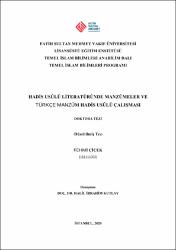Hadis Usülü Literatüründe Manzümeler ve Türkçe Manzüm Hadis Usulü Çalışması
Künye
ÇİÇEK, Fehmi, Hadis Usülü Literatüründe Manzümeler ve Türkçe Manzüm Hadis Usulü Çalışması, Fatih Sultan Mehmet Vakıf Üniversitesi Lisansüstü Eğitim Enstitüsü Temel İslam Bilimleri Anabilim Dalı, Yayımlanmamış Doktora Tezi, İstanbul 2020.Özet
Tarihte ve günümüzde, daha güzel ve etkileyici konuşma yapabilmek için şiir dilinin kullanıldığını hemen hemen dünyanın bütün toplumlarında görmek mümkündür. Bir belâgat mucizesi olan Kur‟an‟a inanan Müslümanlar, şiir dilini sadece günlük hayatın konuşmalarında kullanmakla yetinmeyip hukuktan siyasete, eğitimden ekonomiye, tıptan astronomiye kadar birçok manzûmeler yazmışlardır. Hatta daha da ileriye giderek, Tefsir, Hadis, Fıkıh gibi ilimlerin metodolojilerini belirleyen usûl kitaplarını, bin beyte varan manzûmelerle kaleme almışlardır.
Rivayet edilen haberlerden hangisinin makbûl, hangisinin merdûd olduğunu tespit etmek maksadıyla kurulan Hadis Usûlü ilminin temel esasları, Hz. Peygamber (s.a.v.) ve sahabe döneminde doğmuş, hicri ikinci ve üçüncü asırda gelişmiş, dördüncü asırda Râmhürmüzî‟nin (ö. 360/971) “el-Muhaddisü‟l-fâsıl” eseriyle müstakil bir disiplin haline gelmiştir. Hâkim en-Nîsâbûrî (ö. 405/1014), Hatîb el-Bağdâdî (ö. 463/1071) ve ibnü‟s-Salâh (ö. 643/1245) ile iyice zenginleşmiştir. Yedinci asrın ortalarında ibn Ferah el-işbîlî‟nin (ö. 699/1300) “Garâmî Sahîh” manzûmesi ile farklı bir boyut kazanan Hadis Usûlü, artık manzûm olarak yazılmaya başlanmıştır. Giderek islâm dünyasında Hadis Usûlü manzûmeleri artmış, kısa, orta ve uzun birçok manzûmeler yazılmıştır. Mecdüddin el-Fîrûzâbâdî (ö.817/1415), Kemalüddin eş-ġümünnî (ö.821/1419), ibn Zekrî et-Tilimsânî (ö.899/1494), Radıyyüddin el-Gazzî (ö.935/1529) ve ibn Fettûh el-Beykûnî (ö. 1080/1669) gibi âlimlerin manzûmeleri; şihabüddin el-Hüveyyî (ö.693/1294), Zeynüddin el-Irâkî (ö.806/1404), Muhammed b. Abdurrahman el-Berşensî (ö.808/1406) ve Celalüddin es-Süyûtî (ö.911/1506) gibi âlimlerin Elfiyye‟leri, Hadis Usûlü‟nde yazılan belli başlı manzûm eserler arasında yer almıştır.
Cumhuriyet dönemi Hadis Usûlü alanında yazılan yüksek lisans ve doktora tezlerinin (hemen) hepsi mensûr eserler hakkındadır. Manzûm Hadis Usûlü eserleri hakkında doktora seviyesinde bir çalışma tespit edilememiştir. 800‟ün üzerinde yüksek lisans tezinden sadece bir tanesi manzûm eserler ile ilgilidir. O da Irâkî‟nin Elfiyye‟si ile sınırlıdır. Dolayısıyla “Hadis Usûlü Literatüründe Manzûm Eserler ve Türkçe Manzûm Hadis Usûlü Çalışması” adlı doktora tezimiz –eğer daha önce bir benzeri yoksa- alanında bir “ilk”tir. Diğer taraftan, Cumhuriyet dönemi Hadis Usûlü eserleri arasında, ne akademik ne de sıradan bir Türkçe Manzûm Hadis Usûlü çalışması bulunmaktadır. Bu nedenle 7+7=14‟lü hece yapısı, zengin kâfiyeleri, akademik muhtevası ve çekici üslubu ile 80 beyitlik “el-Manzûmetü‟l-fehmiyye” adlı Türkçe Manzûm Hadis Usûlü çalışmamız, yine alanında bir “ilk”tir. Bu çalışmamızın, lisans ve lisansüstü seviyede Hadis Usûlü ilmini daha kolay ve daha çekici bir yöntemle öğrenim ve öğretilmesine katkı sağlamasına, ilerde daha güzel ve daha zengin çalışmaların yapılmasına vesile olması ümit edilmektedir. It is possible to see in history and modern societies across the world that the language of poetry has been used to produce more eloquent and impressive speech. Muslim scholars who believe the Holy Qur'an is a miracle of eloquence have not only contented to use the language of poetry in every day speech, but have written many books of sciences ranging from law to politics, education to economics, medicine to astronomy in poetic form. In fact, some scholars even wrote technical (procedural) books with rhyming couplets of up to a thousand verses outlining the methodology of sciences such as Tafsir, Hadith and Fiqh. The science of Hadith methodology, introduced to establish the veracity of statements attributed to the Prophet Muhammad, originated during the lifetime of the Prophet and his companions. It was subsequently developed in the second and third century. However, in the fourth century, it became an independent discipline with the work of Râmhürmüdhî (d. 360/971) in his famous book Al-Muhaddithu‟l-Fâsel. The works of Hâkim an-Nîsâbûrî (d. 405/1014), Hatîb el-Bağdâdî (d. 463/1071) and ibn Salah (d. 643/1245) further enriched the science. In the middle of the seventh century, the methodology of Hadith took on a different dimension with the introduction of the poetry of Garâmî Sahîh by Ibn Farah al-Eshbîlî (d. 699/1300). Since then, the methodology of Hadith has been written in short, medium and long poetic forms in different parts of Islamic world. The Mandhuumah (short and medium poem couplets less than a thousand) of Majduddin al-Fîrûzâbâdî (d.817/1415), Kamaluddin ash-Shumunnî (d.821/1419), Ibn Zakrî at-Tilimsânî (d.899/1494), Radhiyyuddin al-Gazzî (d.935/1529), Ibn Fattûh al-Baiqûnî (d.1080/1669) and the Alfeyyah (poems more than one thousand couplets) of Shehâbuddin al-Huvaiyî (d.693/1294), Zaiynuddin al-Irâkî (d.806/1404), Mohammad b. Abdorrahmân al-Barshansî (d.808/1406) and Jalaaluddin as-Süyûtî (d.911/1506) are among the major works written on the methodology of Hadith In the main, master's and doctoral theses written in the field of the methodology of the Hadith in the Republic of Turkey focus on works produced in written prose. In particular, there are no PHD theses about poetic books written in the methodology of the Hadith. There is not that a single paper of over 800 master's theses reflect on poetic works. This just limited to the Alfeyyah of al-Irâki. So, our PHD thesis named `Poetic Books in the Literature of the Methodology of Hadith and a Turkish Poetry Work in the Methodology of Hadith` is a first study in this field. Unfortunately, there is no academic or other Turkish poetic book written in the methodology of Hadith in the history of Turkish Republic. Therefore, 7 + 7 = 14 syllable structure, rich heirlooms, academic content and attractive style with 80 couplets, Al-Mandhûmah al-Fahmiyyah in the methodology of Hadith again in the field is a first. This study – I hope- will not only contribute to the education and teaching of the Hadith methodology in an easy and more attractive way, both at undergraduate and postgraduate level, but in addition will lead to the production of other works more refined and eloquent in this field.



















